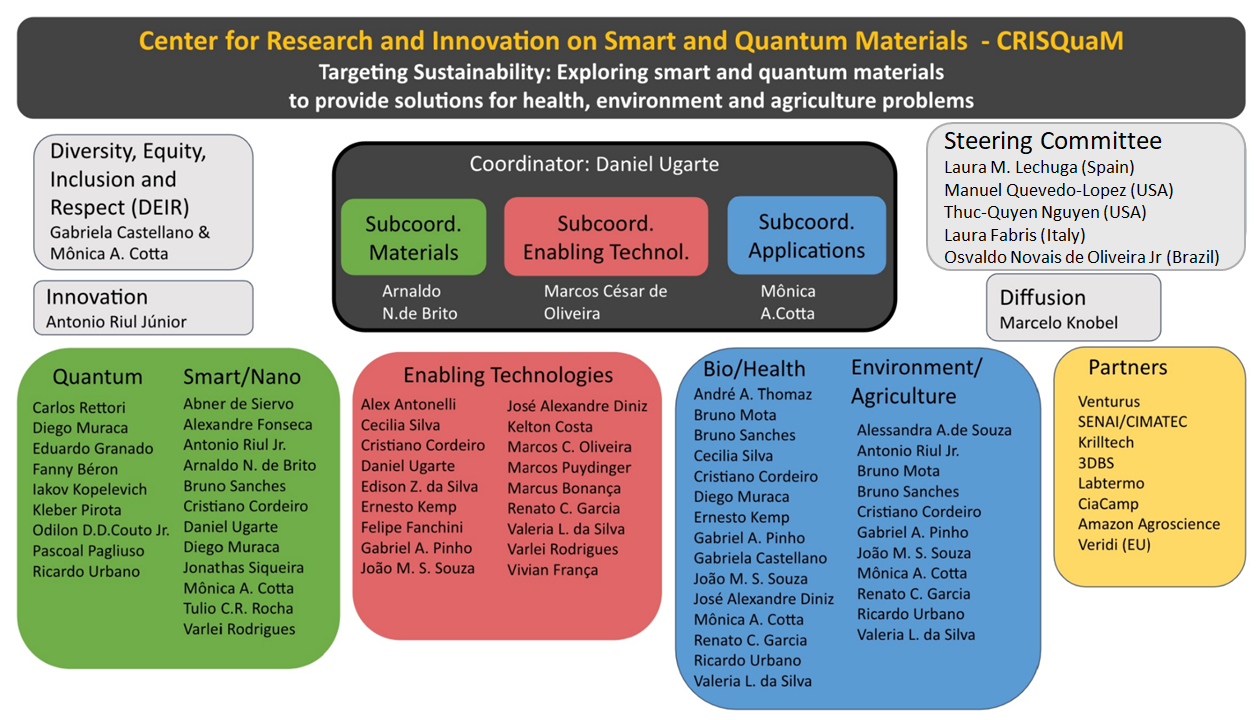BV-FAPESP: research projects supported in this Center
CRISQuaM in the Media: news about the center
CRISQuaM aims to explore the synergistic development of fundamental and applied science to create new materials with high potential for the construction of devices and sensors to address technological challenges related to sustainability, climate change, precision agriculture, ecology, and health. To achieve these goals, we have assembled an interdisciplinary and collaborative research team, integrating expertise across various scientific domains, researching novel materials with high innovation potential. By combining original synthesis methods, advanced characterization techniques, theoretical approaches, computational simulations, quantum technologies, and device construction designs, we aim to drive advances in smart and quantum materials, promoting scientific excellence and technological development. With this, we plan disruptive innovations in instrumentation—including hardware and AI-based tools—as well as in quantum technologies, biomedical devices, and signal processing, in addition to plant bionics, exploring plant-pathogen interactions. Besides research activities, we plan intensive actions in education, dissemination, and communication for the general public, as a modern society should be aware of the challenges humanity faces and how research and technology are essential for responsibly utilizing the planet's limited resources. CRISQuaM's Innovation activities are accelerated through partnerships with several companies in related technologies, many of them Brazilian. Finally, all activities of the Center are managed in accordance with diversity, equity, and inclusion goals and best practices.
The Center brings together scientists, engineers, and innovators in a collaborative effort to apply materials science and quantum technologies at the cutting edge, designing new materials and nano(bio)sensors for advanced diagnostics. The Center has a team capable of producing a wide range of (nano/micro) materials, along with precise chemical and physical characterizations using modern techniques (synchrotron, advanced microscopy, magnetotransport, magnetic resonance, optics, etc.). In addition, the team offers various options in enabling technologies, including miniaturization, processing, and additive manufacturing, as well as instrumentation, quantum sensing, and electronics development. Data analysis will employ updated approaches (numerical simulation, classical and quantum machine learning, and quantum optimization). Applications at the knowledge frontier will address urgent sustainability needs in environmental areas, precision agriculture, plant bionics, and biomedical interfaces, contributing to the development of local technologies in close partnership with the Brazilian industry.
The organization of the Center is based on three pillars — Materials, Enabling Technologies, and Applications — together with partner companies, as described in the figure below.

2024-06-19
Developed by researchers at the University of São Paulo in Brazil, the system used the port city of Santos as a sample space, and could enhance the efficiency of civil defense activities in the context of extreme weather events.
2024-06-19
Bacteria, fungi and archaea that live in soil act as a methane sink, among other ecosystem services, but deforestation can reduce their functional diversity, Brazilian, British and American researchers warn in the journal Trends in Ecology and Evolution.
2024-06-17
New analysis of an archaeological site near the town of Laguna refutes the theory that the ancestors of the Southern Jê replaced the people who built shell middens and burial mounds known as sambaquis for more than 5,000 years on the coast of Santa Catarina state. The results are reported in PLOS ONE.
2024-06-12
The use of photobiomodulation and an antioxidant drug called idebenone strengthened the regenerative capacity of muscle fibers in an experimental model, a study conducted at the State University of Campinas shows.
2024-06-12
A study conducted in a medium-sized city in São Paulo state (Brazil) found that chikungunya, which has caused major epidemics in several countries, can also circulate silently in a community, with few infections for years. The researchers produced a new profile of this arbovirus, underscoring the importance of disease surveillance to predict and prepare efficiently for epidemics.
2024-06-12
An analysis of scientific papers published in a 15-year period on molecular methods to identify elasmobranch species shows that better detection of illegal trade has not enhanced protection.